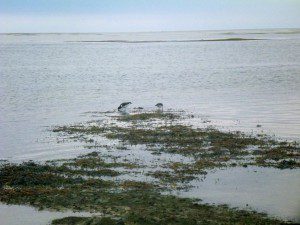Rob Diaz de Villegas WFSU-TV

 When we started doing Notes From the Field, the intention was for the researchers and their techs and students to write about interesting things they saw or did while conducting their studies. But I’m sneaking one in. A couple of weeks ago I went out to Bay Mouth Bar with David Kimbro and his crew for their monthly sampling of gastropods and bivalves. Horse conchs were plentiful during the summer months, but as the temperature drops they leave for deeper and warmer waters. WFSU videographer Dan Peeri and I walked around getting shots of dead turtlegrass, a sign of seasonal change. Oystercatchers were eating sea urchins; how close would they and the other birds let us get?
When we started doing Notes From the Field, the intention was for the researchers and their techs and students to write about interesting things they saw or did while conducting their studies. But I’m sneaking one in. A couple of weeks ago I went out to Bay Mouth Bar with David Kimbro and his crew for their monthly sampling of gastropods and bivalves. Horse conchs were plentiful during the summer months, but as the temperature drops they leave for deeper and warmer waters. WFSU videographer Dan Peeri and I walked around getting shots of dead turtlegrass, a sign of seasonal change. Oystercatchers were eating sea urchins; how close would they and the other birds let us get?
It was an interesting but quiet day when we heard a shout at the west end of the bar, facing the open Gulf. Hanna Garland, newly returned from her graduate study on the crown conch problem south of Saint Augustine, seemed to have found something interesting. Whenever there’s yelling at Bay Mouth Bar, there’s good footage to be found. Hanna had found a pair of horse conchs mating. There were several of the football sized orange snails on this side of the bar, including a second coupled pair. It seems that they hadn’t quite made it to deeper waters, but were perhaps on the way. And the behavior we observed got my imagination going. Do they mate before heading on, laying their eggs in deeper waters? Is that why they leave in the winter, leaving the door open for increased lightning whelk activity? We can’t say that based on things we saw one day. But that is one of the wonderful things about visiting wild habitats: seeing animals behave in different ways and getting glimpses into why things happen the way they do (even if careful study ends up providing an alternate narrative).
Horse conchs make an appearance in my EcoAdventures segment on the Leave No Trace principles on tonight’s episode of Dimensions, at 7:30 PM/ ET. Part of visiting wild places and witnessing interesting behavior is not influencing it with your own behavior. We go over best practices for not disturbing a habitat and its inhabitants. And for those who haven’t gotten enough Apalachicola River video, our State Parks One Tank Adventure segment tonight is on Torreya State Park. Also, you can check out our new Apalachicola River and Bay Basin page, under the EcoAdventures North Florida menu. From there you’ll have access to all of our videos on the basin (beyond the river and the bay) and play with our interactive photo map.
We want to hear from you! Who has seen any interesting animal behavior based on seasonal change? Add your question or comment.
In the Grass, On the Reef is funded by the National Science Foundation.
